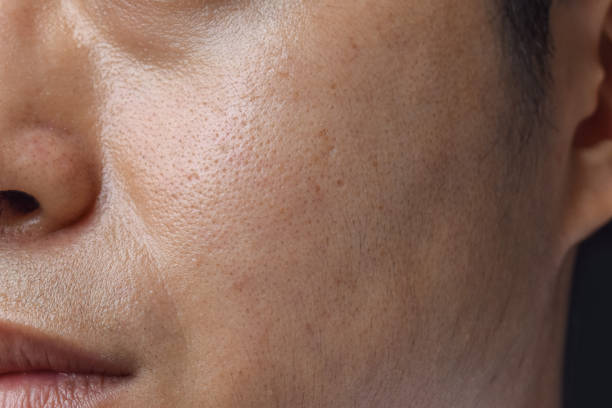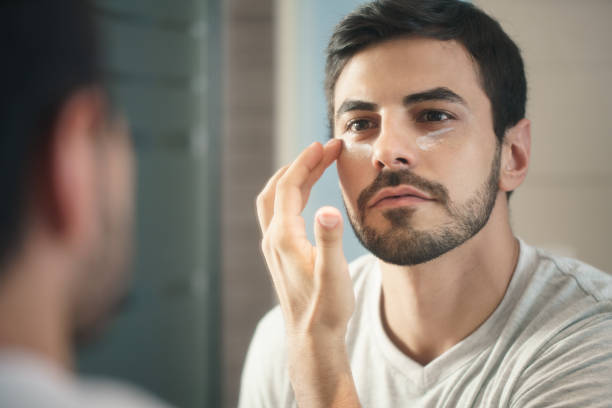Men’s skin care has evolved beyond just soap and water. Today, it’s about understanding your skin type and creating a routine that addresses specific concerns while maintaining overall skin health. Whether you have oily, dry, combination or sensitive skin, this guide will teach you the essentials of men’s skin care and how to create a routine that fits your needs.

Why Men’s Skin Care Matters
The skin is the body’s largest organ and acts as a barrier against environmental pollutants, harmful UV rays and bacteria. For men, high testosterone levels cause skin to be thicker and oilier, which can lead to specific skin care concerns like clogged pores, acne and rough texture. Establishing a daily skin care routine can not only improve your appearance but also improve your skin’s health, preventing premature aging, acne, and other common issues.
Skincare Basics for Men
Before we get into specific routines for different skin types, let’s cover some essential steps that should be part of every man’s skincare routine:

- Cleansing: Cleansing is the foundation of any type skincare routine. It helps remove dirt, oil, and impurities that accumulate throughout the day. For men, finding a gentle yet effective cleanser is important to prevent overdrying or irritating the skin. Choose a sulfate-free cleanser that won’t strip the skin of its natural oils.
- Exfoliating: Exfoliation helps you to remove your dead skin cells, unclog pores, and promote your cell turnover. Although men have thicker skin, that doesn’t mean exfoliating daily is a must. Depending on your skin type, aim to exfoliate two to three times a week.
- Moisturizing: Moisturizers are a must for hydrating the skin and locking in moisture. Even if you have oily skin, don’t skip this step. The right moisturizer can balance your skin’s natural oils and provide a protective barrier against environmental stressors.
- Sun protection: Sunscreen is often overlooked, but it’s one of the most important steps in skin care. UV damage is a leading cause of premature aging, fine lines, wrinkles, and even skin cancer. Choose a broad-spectrum SPF 30 or higher and apply it daily, even if you don’t spend much time outdoors.
Understanding your skin type
Knowing your skin type is the first step to creating an effective skin care routine. Men’s skin can generally be classified into four types:

- Oily skin: Oily skin produces more sebum (oil), making the skin shiny, pores enlarged and more prone to acne or blackheads. If you often find your skin greasy by midday, you probably have oily skin.
- Dry skin: Dry skin lacks moisture, often resulting in tightness, flakiness and rough patches. Men with dry skin may experience irritation, redness and sensitivity, especially during the colder months.
- Combined skin: Mixed skin is a mix of oily and dry skin. Typically, the T-zone (forehead, nose and chin) is oily, while your cheeks and your other areas are dry or normal.
- Sensitive skin: Sensitive skin is prone to redness and irritation, reactions to certain products. If skin stings, burns, or breaks out easily after using skincare products, you probably have sensitive skin.
Creating a Skincare Routine for Oily Skin
Oily skin can be challenging to manage because of excessive sebum production. However, the right routine can help keep oiliness and acne under control without stripping the skin of essential moisture.

Morning Routine:
- Cleanser: Use a gentle, foaming cleanser that’s designed to control oil production. Look for ingredients like salicylic acid or tea tree oil, which help reduce excess oil and prevent clogged pores.
- Toner: Apply a toner with witch hazel or glycolic acid to help tighten pores and balance oil production.
- Moisturizer: Even with oily skin, moisturizing is essential. Choose a lightweight, oil-free, and non-comedogenic (non-clogging pores) moisturizer to hydrate your skin without giving it extra shine.
- Sunscreen: Choose a mattifying sunscreen that absorbs oil and provides broad-spectrum protection. Gel-based sunscreens are good for oily skin.
Evening routine:
- Cleanser: Cleanse twice at night if needed to remove excess oil and impurities. Start with an oil-based cleanser to dissolve sebum followed by a water-based cleanser.
- Exfoliator: Exfoliate two to three times a week to prevent clogged pores and acne. Use a product with salicylic acid to clear away dead skin and keep pores clear.
- Treatment: Consider using a retinoid or salicylic acid serum to control oil production and promote skin cell renewal.
- Moisturizer: Apply the same lightweight, oil-free moisturizer used in the morning.
Creating a Skincare Routine for Dry Skin
Dry skin needs deeply hydrating and gentle products that won’t strip out natural oils. The key is to focus on replenishing moisture and avoiding harsh ingredients that can exacerbate dryness.

Morning Routine:
- Cleanser: Use a creamy, hydrating cleanser that gently cleanses without over-drying. Must look for ingredients like hyaluronic acid and glycerin to lock in moisture.
- Toner: Choose an alcohol-free hydrating toner with rosewater or aloe vera to soothe and relax skin.
- Moisturizer: Apply a rich, soft moisturizer to deeply hydrate skin. Cream-based formulas are ideal for providing long-lasting moisture.
- Sunscreen: Use a moisturizing sunscreen with hydrating ingredients like ceramides or hyaluronic acid to protect and nourish skin.
Evening routine:
- Cleanser: Use the same gentle cleanser as in the morning to remove dirt and impurities without stripping the skin.
- Exfoliator: Exfoliate once or twice a week with a mild scrub or enzyme-based exfoliant to remove dead skin cells and allow better absorption of moisturizers.
- Serum: Apply a hydrating serum containing hyaluronic acid to plump and hydrate the skin.
- Moisturizer: Use a heavier night cream or oil-based moisturizer to lock in moisture while you sleep. You can also incorporate a facial oil like jojoba or argan oil for extra hydration.
Creating a skincare routine for mixed skin
Mixed skin requires a balanced approach to treat both the oily and dry areas of your face. It is often necessary to target specific areas with different products to keep your skin balanced and healthy.

Morning routine:
- Cleanser: Use a gel or foam cleanser that’s gentle enough for dry areas and controls oil in the T-zone. Don’t use harsh cleansers that can strip the skin.
- Toner: Use a balancing toner with ingredients like niacinamide or witch hazel to control oil in the T-zone without over-drying the rest of the face.
- Moisturizer: Choose a light, oil-free moisturizer for the T-zone and a more hydrating formula for the drier parts of the face.
- Sunscreen: Use a broad-spectrum SPF 30 sunscreen that won’t clog pores or add shine. Gel-based sunscreens are good for combination skin.
Evening routine:
- Cleanser: Cleanse twice at night to remove oil, dirt, and makeup. Use an oil-based cleanser first, followed by a light foaming cleanser.
- Exfoliator: Exfoliate two to three times a week, focusing on the T-zone to prevent clogging of pores. Avoid over-exfoliating dry areas.
- Serum: Apply a balancing serum containing ingredients like niacinamide or hyaluronic acid to address both oil production and hydration.
- Moisturizer: Use a lightweight moisturizer on oily areas and a more nourishing formula on dry patches. You can also use a hydrating serum on dry areas for extra moisture.
Creating a skincare routine for sensitive skin
Sensitive skin needs extra care to prevent irritation, redness, and breakouts. The focus should be on soothing ingredients and avoiding products with harsh chemicals, fragrances, or alcohol.

Morning routine:
- Cleanser: Choose a gentle, fragrance-free cleanser designed for your sensitive skin. Must look for soothing ingredients like aloe vera, chamomile, or oatmeal.
- Toner: Use an alcohol-free toner with calming ingredients like rosewater or chamomile to soothe irritation and redness.
- Moisturizer: Apply a fragrance-free, hypoallergenic moisturizer to protect and hydrate skin without causing irritation.
- Sunscreen: Choose a mineral-based sunscreen containing zinc oxide or titanium dioxide, which are less likely to cause irritation than chemical sunscreens.
Evening routine:
- Cleanser: Use the same gentle cleanser to remove dirt and impurities.
- Exfoliator: Exfoliate with a very mild exfoliant once a week. Avoid harsh scrubs or acids that can irritate sensitive skin.
- Serum: Use a calming serum with ingredients like niacinamide or aloe vera to reduce inflammation and strengthen the skin barrier.
- Moisturizer: Apply the same gentle, fragrance-free moisturizer to lock in moisture and protect skin overnight.
Additional Tips for Men’s Skin Care
- Consistency is key: Results of a skin care routine won’t show overnight. Be consistent with your routine for at least a few weeks to see improvements.
- Shaving care: Shaving can cause irritation, especially for those with sensitive skin. Use a shaving gel or cream suited to your skin type and shave in the direction of hair growth to prevent razor bumps and cuts.
- Hydration: Drink plenty of water throughout your day to keep your skin hydrated from the inside. Dehydration can make skin look dull and Increases dryness.
- Avoid over-exfoliating: Exfoliating helps remove dead skin cells, but doing it too often can damage the skin barrier and lead to irritation, redness and acne.
Conclusion
Creating a skincare routine tailored to your skin type is key to maintaining healthy, glowing skin. Whether you have oily, dry, combination or sensitive skin, the steps above will help you address your specific concerns and keep your skin in tip-top condition. Remember, skincare is a long-term commitment, but with the right products and consistency, you’ll see the benefits in no time. Taking care of your skin isn’t just about looking good—it’s about feeling confident and maintaining your skin’s health for years to come.





